Analysis: Socio-Economic Impact of House Prices on Sydney's Poor
VerifiedAdded on 2024/05/31
|10
|2663
|57
Report
AI Summary
This report investigates the socio-economic impact of rising house prices in Sydney on low-income individuals. It highlights the increasing unaffordability of housing, with Sydney becoming one of the most expensive cities for homeownership. The research aims to identify factors contributing to the price hike, including economic conditions, government policies, and demographic factors, and their effects on the low-income population. The methodology employs quantitative research, using questionnaires and interviews with low-income residents to gather primary data. The data collected is analyzed to determine the extent to which rising housing prices affect the socio-economic well-being of low-income individuals in Sydney, considering aspects like housing affordability, access to employment, and overall living costs. The report also acknowledges limitations such as funding and time constraints and proposes further research to develop effective strategies for addressing housing affordability issues.
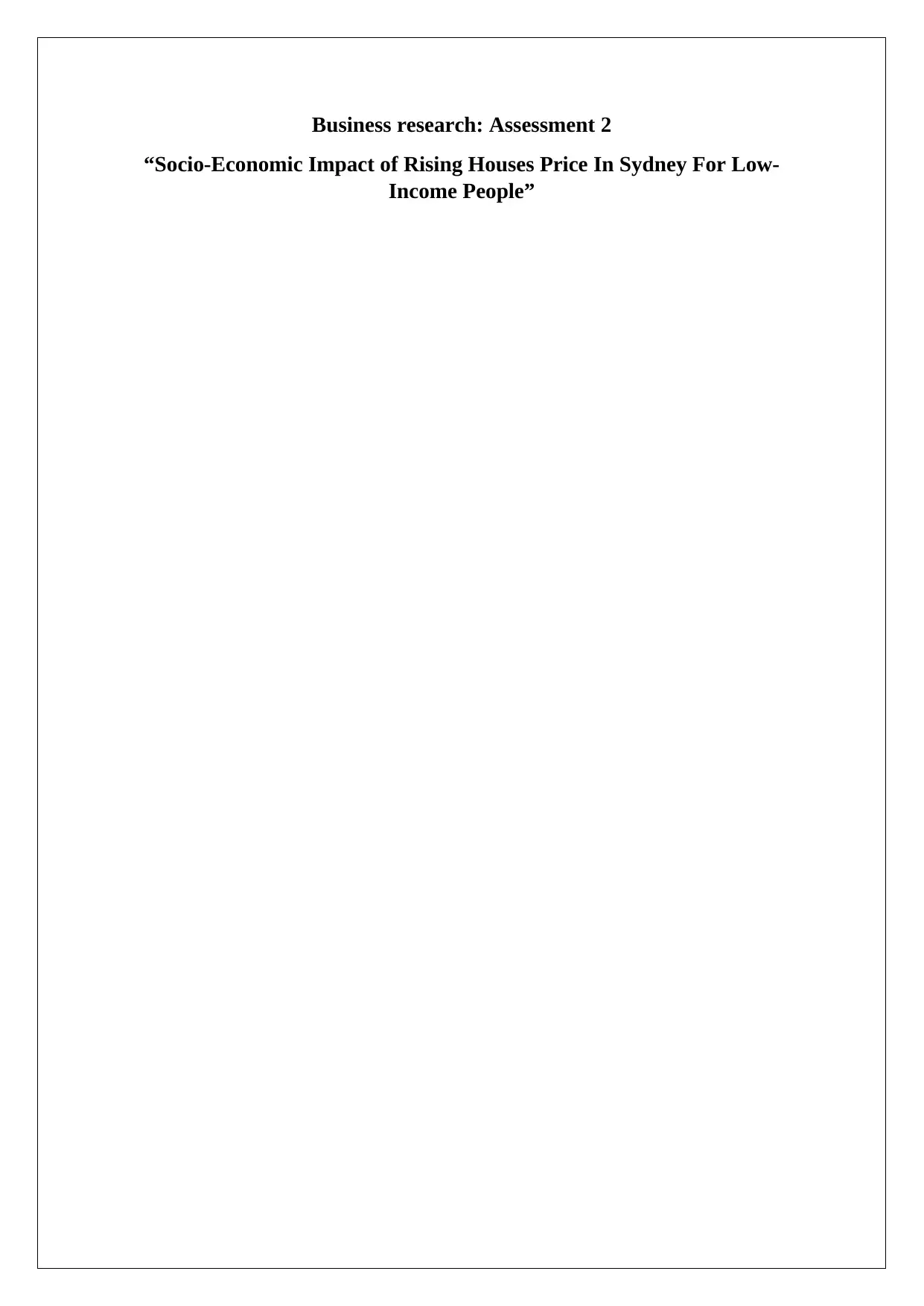
Business research: Assessment 2
“Socio-Economic Impact of Rising Houses Price In Sydney For Low-
Income People”
“Socio-Economic Impact of Rising Houses Price In Sydney For Low-
Income People”
Paraphrase This Document
Need a fresh take? Get an instant paraphrase of this document with our AI Paraphraser
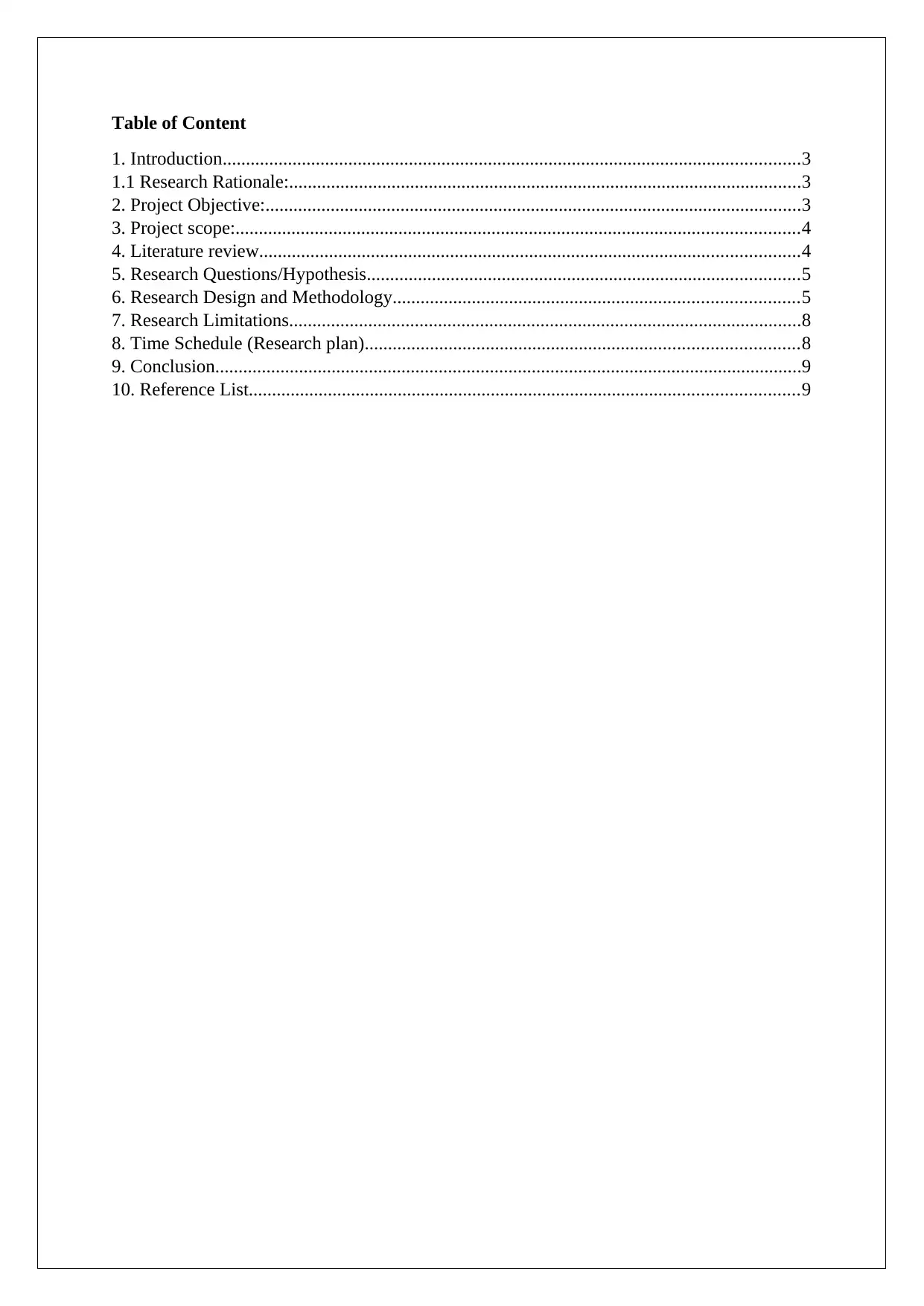
Table of Content
1. Introduction............................................................................................................................3
1.1 Research Rationale:..............................................................................................................3
2. Project Objective:...................................................................................................................3
3. Project scope:.........................................................................................................................4
4. Literature review....................................................................................................................4
5. Research Questions/Hypothesis.............................................................................................5
6. Research Design and Methodology.......................................................................................5
7. Research Limitations..............................................................................................................8
8. Time Schedule (Research plan).............................................................................................8
9. Conclusion..............................................................................................................................9
10. Reference List......................................................................................................................9
1. Introduction............................................................................................................................3
1.1 Research Rationale:..............................................................................................................3
2. Project Objective:...................................................................................................................3
3. Project scope:.........................................................................................................................4
4. Literature review....................................................................................................................4
5. Research Questions/Hypothesis.............................................................................................5
6. Research Design and Methodology.......................................................................................5
7. Research Limitations..............................................................................................................8
8. Time Schedule (Research plan).............................................................................................8
9. Conclusion..............................................................................................................................9
10. Reference List......................................................................................................................9
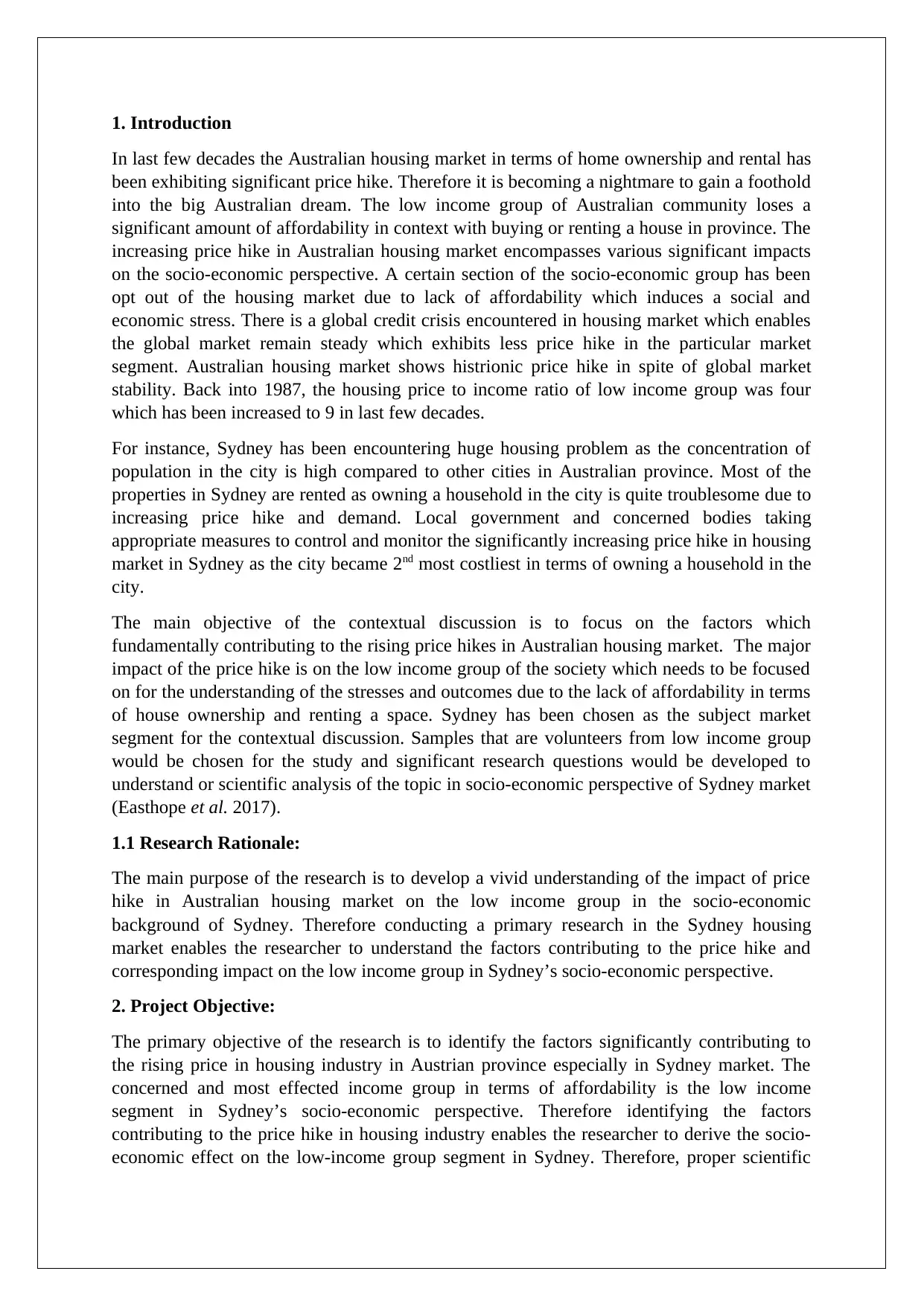
1. Introduction
In last few decades the Australian housing market in terms of home ownership and rental has
been exhibiting significant price hike. Therefore it is becoming a nightmare to gain a foothold
into the big Australian dream. The low income group of Australian community loses a
significant amount of affordability in context with buying or renting a house in province. The
increasing price hike in Australian housing market encompasses various significant impacts
on the socio-economic perspective. A certain section of the socio-economic group has been
opt out of the housing market due to lack of affordability which induces a social and
economic stress. There is a global credit crisis encountered in housing market which enables
the global market remain steady which exhibits less price hike in the particular market
segment. Australian housing market shows histrionic price hike in spite of global market
stability. Back into 1987, the housing price to income ratio of low income group was four
which has been increased to 9 in last few decades.
For instance, Sydney has been encountering huge housing problem as the concentration of
population in the city is high compared to other cities in Australian province. Most of the
properties in Sydney are rented as owning a household in the city is quite troublesome due to
increasing price hike and demand. Local government and concerned bodies taking
appropriate measures to control and monitor the significantly increasing price hike in housing
market in Sydney as the city became 2nd most costliest in terms of owning a household in the
city.
The main objective of the contextual discussion is to focus on the factors which
fundamentally contributing to the rising price hikes in Australian housing market. The major
impact of the price hike is on the low income group of the society which needs to be focused
on for the understanding of the stresses and outcomes due to the lack of affordability in terms
of house ownership and renting a space. Sydney has been chosen as the subject market
segment for the contextual discussion. Samples that are volunteers from low income group
would be chosen for the study and significant research questions would be developed to
understand or scientific analysis of the topic in socio-economic perspective of Sydney market
(Easthope et al. 2017).
1.1 Research Rationale:
The main purpose of the research is to develop a vivid understanding of the impact of price
hike in Australian housing market on the low income group in the socio-economic
background of Sydney. Therefore conducting a primary research in the Sydney housing
market enables the researcher to understand the factors contributing to the price hike and
corresponding impact on the low income group in Sydney’s socio-economic perspective.
2. Project Objective:
The primary objective of the research is to identify the factors significantly contributing to
the rising price in housing industry in Austrian province especially in Sydney market. The
concerned and most effected income group in terms of affordability is the low income
segment in Sydney’s socio-economic perspective. Therefore identifying the factors
contributing to the price hike in housing industry enables the researcher to derive the socio-
economic effect on the low-income group segment in Sydney. Therefore, proper scientific
In last few decades the Australian housing market in terms of home ownership and rental has
been exhibiting significant price hike. Therefore it is becoming a nightmare to gain a foothold
into the big Australian dream. The low income group of Australian community loses a
significant amount of affordability in context with buying or renting a house in province. The
increasing price hike in Australian housing market encompasses various significant impacts
on the socio-economic perspective. A certain section of the socio-economic group has been
opt out of the housing market due to lack of affordability which induces a social and
economic stress. There is a global credit crisis encountered in housing market which enables
the global market remain steady which exhibits less price hike in the particular market
segment. Australian housing market shows histrionic price hike in spite of global market
stability. Back into 1987, the housing price to income ratio of low income group was four
which has been increased to 9 in last few decades.
For instance, Sydney has been encountering huge housing problem as the concentration of
population in the city is high compared to other cities in Australian province. Most of the
properties in Sydney are rented as owning a household in the city is quite troublesome due to
increasing price hike and demand. Local government and concerned bodies taking
appropriate measures to control and monitor the significantly increasing price hike in housing
market in Sydney as the city became 2nd most costliest in terms of owning a household in the
city.
The main objective of the contextual discussion is to focus on the factors which
fundamentally contributing to the rising price hikes in Australian housing market. The major
impact of the price hike is on the low income group of the society which needs to be focused
on for the understanding of the stresses and outcomes due to the lack of affordability in terms
of house ownership and renting a space. Sydney has been chosen as the subject market
segment for the contextual discussion. Samples that are volunteers from low income group
would be chosen for the study and significant research questions would be developed to
understand or scientific analysis of the topic in socio-economic perspective of Sydney market
(Easthope et al. 2017).
1.1 Research Rationale:
The main purpose of the research is to develop a vivid understanding of the impact of price
hike in Australian housing market on the low income group in the socio-economic
background of Sydney. Therefore conducting a primary research in the Sydney housing
market enables the researcher to understand the factors contributing to the price hike and
corresponding impact on the low income group in Sydney’s socio-economic perspective.
2. Project Objective:
The primary objective of the research is to identify the factors significantly contributing to
the rising price in housing industry in Austrian province especially in Sydney market. The
concerned and most effected income group in terms of affordability is the low income
segment in Sydney’s socio-economic perspective. Therefore identifying the factors
contributing to the price hike in housing industry enables the researcher to derive the socio-
economic effect on the low-income group segment in Sydney. Therefore, proper scientific
⊘ This is a preview!⊘
Do you want full access?
Subscribe today to unlock all pages.

Trusted by 1+ million students worldwide
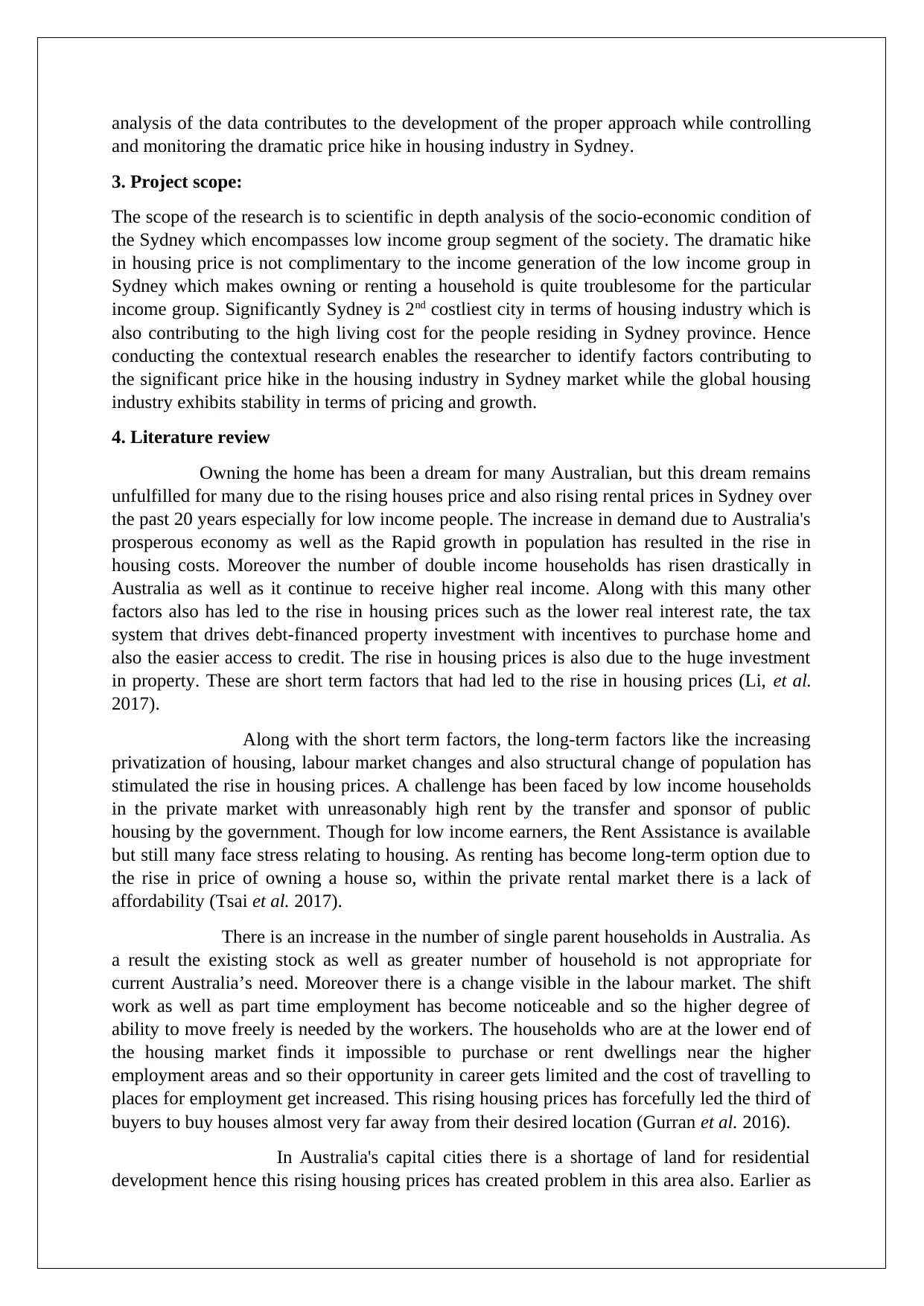
analysis of the data contributes to the development of the proper approach while controlling
and monitoring the dramatic price hike in housing industry in Sydney.
3. Project scope:
The scope of the research is to scientific in depth analysis of the socio-economic condition of
the Sydney which encompasses low income group segment of the society. The dramatic hike
in housing price is not complimentary to the income generation of the low income group in
Sydney which makes owning or renting a household is quite troublesome for the particular
income group. Significantly Sydney is 2nd costliest city in terms of housing industry which is
also contributing to the high living cost for the people residing in Sydney province. Hence
conducting the contextual research enables the researcher to identify factors contributing to
the significant price hike in the housing industry in Sydney market while the global housing
industry exhibits stability in terms of pricing and growth.
4. Literature review
Owning the home has been a dream for many Australian, but this dream remains
unfulfilled for many due to the rising houses price and also rising rental prices in Sydney over
the past 20 years especially for low income people. The increase in demand due to Australia's
prosperous economy as well as the Rapid growth in population has resulted in the rise in
housing costs. Moreover the number of double income households has risen drastically in
Australia as well as it continue to receive higher real income. Along with this many other
factors also has led to the rise in housing prices such as the lower real interest rate, the tax
system that drives debt-financed property investment with incentives to purchase home and
also the easier access to credit. The rise in housing prices is also due to the huge investment
in property. These are short term factors that had led to the rise in housing prices (Li, et al.
2017).
Along with the short term factors, the long-term factors like the increasing
privatization of housing, labour market changes and also structural change of population has
stimulated the rise in housing prices. A challenge has been faced by low income households
in the private market with unreasonably high rent by the transfer and sponsor of public
housing by the government. Though for low income earners, the Rent Assistance is available
but still many face stress relating to housing. As renting has become long-term option due to
the rise in price of owning a house so, within the private rental market there is a lack of
affordability (Tsai et al. 2017).
There is an increase in the number of single parent households in Australia. As
a result the existing stock as well as greater number of household is not appropriate for
current Australia’s need. Moreover there is a change visible in the labour market. The shift
work as well as part time employment has become noticeable and so the higher degree of
ability to move freely is needed by the workers. The households who are at the lower end of
the housing market finds it impossible to purchase or rent dwellings near the higher
employment areas and so their opportunity in career gets limited and the cost of travelling to
places for employment get increased. This rising housing prices has forcefully led the third of
buyers to buy houses almost very far away from their desired location (Gurran et al. 2016).
In Australia's capital cities there is a shortage of land for residential
development hence this rising housing prices has created problem in this area also. Earlier as
and monitoring the dramatic price hike in housing industry in Sydney.
3. Project scope:
The scope of the research is to scientific in depth analysis of the socio-economic condition of
the Sydney which encompasses low income group segment of the society. The dramatic hike
in housing price is not complimentary to the income generation of the low income group in
Sydney which makes owning or renting a household is quite troublesome for the particular
income group. Significantly Sydney is 2nd costliest city in terms of housing industry which is
also contributing to the high living cost for the people residing in Sydney province. Hence
conducting the contextual research enables the researcher to identify factors contributing to
the significant price hike in the housing industry in Sydney market while the global housing
industry exhibits stability in terms of pricing and growth.
4. Literature review
Owning the home has been a dream for many Australian, but this dream remains
unfulfilled for many due to the rising houses price and also rising rental prices in Sydney over
the past 20 years especially for low income people. The increase in demand due to Australia's
prosperous economy as well as the Rapid growth in population has resulted in the rise in
housing costs. Moreover the number of double income households has risen drastically in
Australia as well as it continue to receive higher real income. Along with this many other
factors also has led to the rise in housing prices such as the lower real interest rate, the tax
system that drives debt-financed property investment with incentives to purchase home and
also the easier access to credit. The rise in housing prices is also due to the huge investment
in property. These are short term factors that had led to the rise in housing prices (Li, et al.
2017).
Along with the short term factors, the long-term factors like the increasing
privatization of housing, labour market changes and also structural change of population has
stimulated the rise in housing prices. A challenge has been faced by low income households
in the private market with unreasonably high rent by the transfer and sponsor of public
housing by the government. Though for low income earners, the Rent Assistance is available
but still many face stress relating to housing. As renting has become long-term option due to
the rise in price of owning a house so, within the private rental market there is a lack of
affordability (Tsai et al. 2017).
There is an increase in the number of single parent households in Australia. As
a result the existing stock as well as greater number of household is not appropriate for
current Australia’s need. Moreover there is a change visible in the labour market. The shift
work as well as part time employment has become noticeable and so the higher degree of
ability to move freely is needed by the workers. The households who are at the lower end of
the housing market finds it impossible to purchase or rent dwellings near the higher
employment areas and so their opportunity in career gets limited and the cost of travelling to
places for employment get increased. This rising housing prices has forcefully led the third of
buyers to buy houses almost very far away from their desired location (Gurran et al. 2016).
In Australia's capital cities there is a shortage of land for residential
development hence this rising housing prices has created problem in this area also. Earlier as
Paraphrase This Document
Need a fresh take? Get an instant paraphrase of this document with our AI Paraphraser
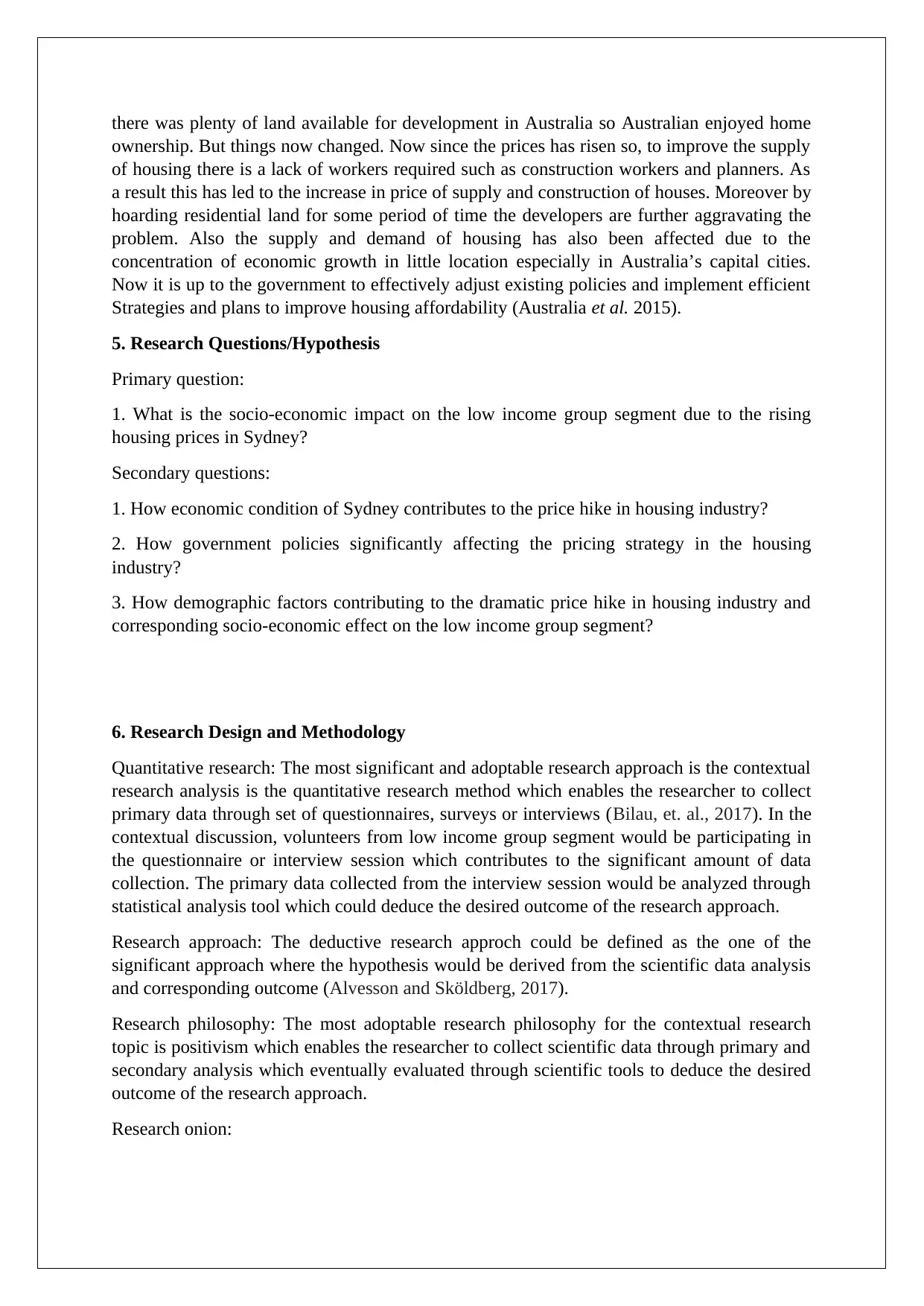
there was plenty of land available for development in Australia so Australian enjoyed home
ownership. But things now changed. Now since the prices has risen so, to improve the supply
of housing there is a lack of workers required such as construction workers and planners. As
a result this has led to the increase in price of supply and construction of houses. Moreover by
hoarding residential land for some period of time the developers are further aggravating the
problem. Also the supply and demand of housing has also been affected due to the
concentration of economic growth in little location especially in Australia’s capital cities.
Now it is up to the government to effectively adjust existing policies and implement efficient
Strategies and plans to improve housing affordability (Australia et al. 2015).
5. Research Questions/Hypothesis
Primary question:
1. What is the socio-economic impact on the low income group segment due to the rising
housing prices in Sydney?
Secondary questions:
1. How economic condition of Sydney contributes to the price hike in housing industry?
2. How government policies significantly affecting the pricing strategy in the housing
industry?
3. How demographic factors contributing to the dramatic price hike in housing industry and
corresponding socio-economic effect on the low income group segment?
6. Research Design and Methodology
Quantitative research: The most significant and adoptable research approach is the contextual
research analysis is the quantitative research method which enables the researcher to collect
primary data through set of questionnaires, surveys or interviews (Bilau, et. al., 2017). In the
contextual discussion, volunteers from low income group segment would be participating in
the questionnaire or interview session which contributes to the significant amount of data
collection. The primary data collected from the interview session would be analyzed through
statistical analysis tool which could deduce the desired outcome of the research approach.
Research approach: The deductive research approch could be defined as the one of the
significant approach where the hypothesis would be derived from the scientific data analysis
and corresponding outcome (Alvesson and Sköldberg, 2017).
Research philosophy: The most adoptable research philosophy for the contextual research
topic is positivism which enables the researcher to collect scientific data through primary and
secondary analysis which eventually evaluated through scientific tools to deduce the desired
outcome of the research approach.
Research onion:
ownership. But things now changed. Now since the prices has risen so, to improve the supply
of housing there is a lack of workers required such as construction workers and planners. As
a result this has led to the increase in price of supply and construction of houses. Moreover by
hoarding residential land for some period of time the developers are further aggravating the
problem. Also the supply and demand of housing has also been affected due to the
concentration of economic growth in little location especially in Australia’s capital cities.
Now it is up to the government to effectively adjust existing policies and implement efficient
Strategies and plans to improve housing affordability (Australia et al. 2015).
5. Research Questions/Hypothesis
Primary question:
1. What is the socio-economic impact on the low income group segment due to the rising
housing prices in Sydney?
Secondary questions:
1. How economic condition of Sydney contributes to the price hike in housing industry?
2. How government policies significantly affecting the pricing strategy in the housing
industry?
3. How demographic factors contributing to the dramatic price hike in housing industry and
corresponding socio-economic effect on the low income group segment?
6. Research Design and Methodology
Quantitative research: The most significant and adoptable research approach is the contextual
research analysis is the quantitative research method which enables the researcher to collect
primary data through set of questionnaires, surveys or interviews (Bilau, et. al., 2017). In the
contextual discussion, volunteers from low income group segment would be participating in
the questionnaire or interview session which contributes to the significant amount of data
collection. The primary data collected from the interview session would be analyzed through
statistical analysis tool which could deduce the desired outcome of the research approach.
Research approach: The deductive research approch could be defined as the one of the
significant approach where the hypothesis would be derived from the scientific data analysis
and corresponding outcome (Alvesson and Sköldberg, 2017).
Research philosophy: The most adoptable research philosophy for the contextual research
topic is positivism which enables the researcher to collect scientific data through primary and
secondary analysis which eventually evaluated through scientific tools to deduce the desired
outcome of the research approach.
Research onion:
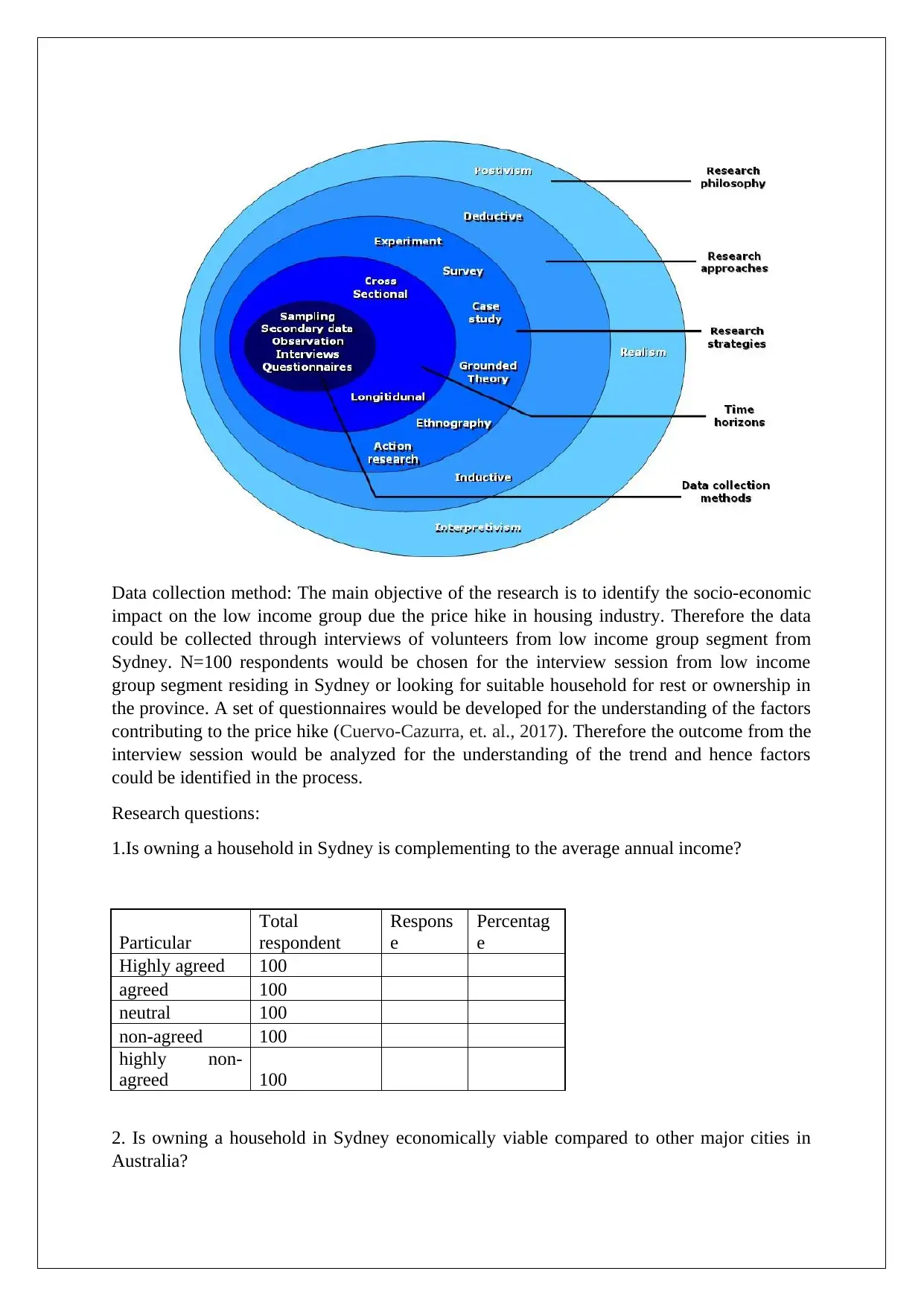
Data collection method: The main objective of the research is to identify the socio-economic
impact on the low income group due the price hike in housing industry. Therefore the data
could be collected through interviews of volunteers from low income group segment from
Sydney. N=100 respondents would be chosen for the interview session from low income
group segment residing in Sydney or looking for suitable household for rest or ownership in
the province. A set of questionnaires would be developed for the understanding of the factors
contributing to the price hike (Cuervo‐Cazurra, et. al., 2017). Therefore the outcome from the
interview session would be analyzed for the understanding of the trend and hence factors
could be identified in the process.
Research questions:
1.Is owning a household in Sydney is complementing to the average annual income?
Particular
Total
respondent
Respons
e
Percentag
e
Highly agreed 100
agreed 100
neutral 100
non-agreed 100
highly non-
agreed 100
2. Is owning a household in Sydney economically viable compared to other major cities in
Australia?
impact on the low income group due the price hike in housing industry. Therefore the data
could be collected through interviews of volunteers from low income group segment from
Sydney. N=100 respondents would be chosen for the interview session from low income
group segment residing in Sydney or looking for suitable household for rest or ownership in
the province. A set of questionnaires would be developed for the understanding of the factors
contributing to the price hike (Cuervo‐Cazurra, et. al., 2017). Therefore the outcome from the
interview session would be analyzed for the understanding of the trend and hence factors
could be identified in the process.
Research questions:
1.Is owning a household in Sydney is complementing to the average annual income?
Particular
Total
respondent
Respons
e
Percentag
e
Highly agreed 100
agreed 100
neutral 100
non-agreed 100
highly non-
agreed 100
2. Is owning a household in Sydney economically viable compared to other major cities in
Australia?
⊘ This is a preview!⊘
Do you want full access?
Subscribe today to unlock all pages.

Trusted by 1+ million students worldwide
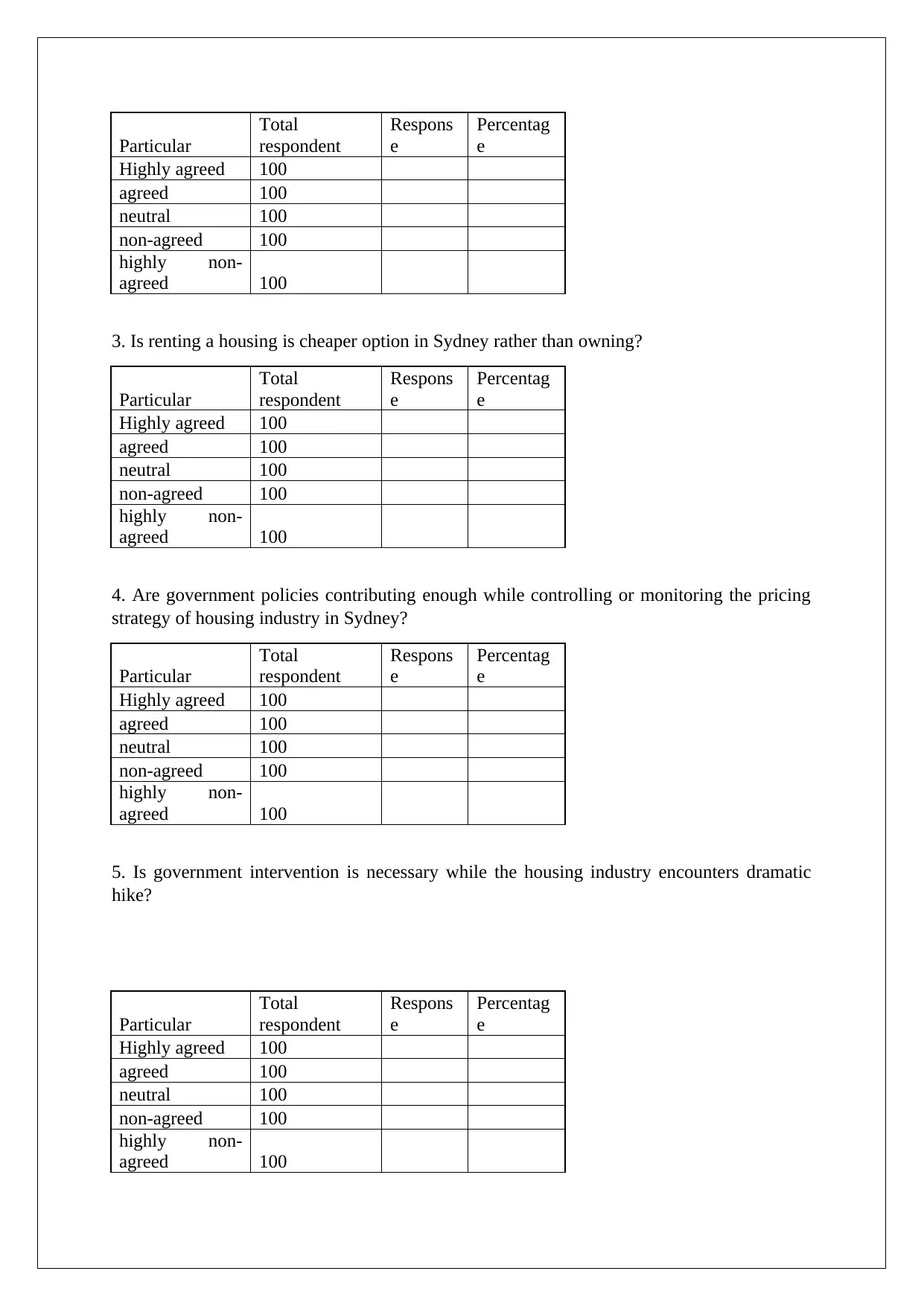
Particular
Total
respondent
Respons
e
Percentag
e
Highly agreed 100
agreed 100
neutral 100
non-agreed 100
highly non-
agreed 100
3. Is renting a housing is cheaper option in Sydney rather than owning?
Particular
Total
respondent
Respons
e
Percentag
e
Highly agreed 100
agreed 100
neutral 100
non-agreed 100
highly non-
agreed 100
4. Are government policies contributing enough while controlling or monitoring the pricing
strategy of housing industry in Sydney?
Particular
Total
respondent
Respons
e
Percentag
e
Highly agreed 100
agreed 100
neutral 100
non-agreed 100
highly non-
agreed 100
5. Is government intervention is necessary while the housing industry encounters dramatic
hike?
Particular
Total
respondent
Respons
e
Percentag
e
Highly agreed 100
agreed 100
neutral 100
non-agreed 100
highly non-
agreed 100
Total
respondent
Respons
e
Percentag
e
Highly agreed 100
agreed 100
neutral 100
non-agreed 100
highly non-
agreed 100
3. Is renting a housing is cheaper option in Sydney rather than owning?
Particular
Total
respondent
Respons
e
Percentag
e
Highly agreed 100
agreed 100
neutral 100
non-agreed 100
highly non-
agreed 100
4. Are government policies contributing enough while controlling or monitoring the pricing
strategy of housing industry in Sydney?
Particular
Total
respondent
Respons
e
Percentag
e
Highly agreed 100
agreed 100
neutral 100
non-agreed 100
highly non-
agreed 100
5. Is government intervention is necessary while the housing industry encounters dramatic
hike?
Particular
Total
respondent
Respons
e
Percentag
e
Highly agreed 100
agreed 100
neutral 100
non-agreed 100
highly non-
agreed 100
Paraphrase This Document
Need a fresh take? Get an instant paraphrase of this document with our AI Paraphraser
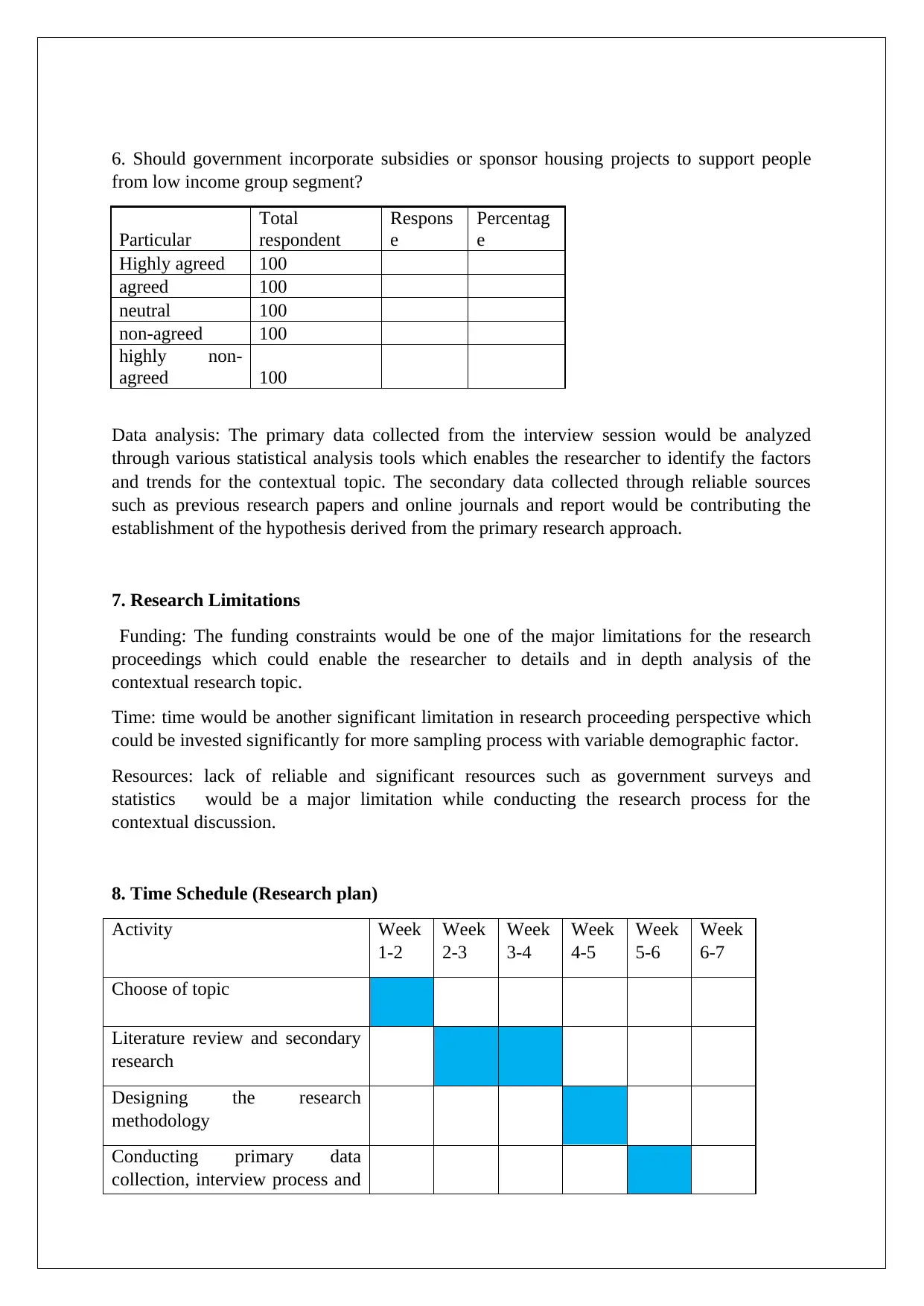
6. Should government incorporate subsidies or sponsor housing projects to support people
from low income group segment?
Particular
Total
respondent
Respons
e
Percentag
e
Highly agreed 100
agreed 100
neutral 100
non-agreed 100
highly non-
agreed 100
Data analysis: The primary data collected from the interview session would be analyzed
through various statistical analysis tools which enables the researcher to identify the factors
and trends for the contextual topic. The secondary data collected through reliable sources
such as previous research papers and online journals and report would be contributing the
establishment of the hypothesis derived from the primary research approach.
7. Research Limitations
Funding: The funding constraints would be one of the major limitations for the research
proceedings which could enable the researcher to details and in depth analysis of the
contextual research topic.
Time: time would be another significant limitation in research proceeding perspective which
could be invested significantly for more sampling process with variable demographic factor.
Resources: lack of reliable and significant resources such as government surveys and
statistics would be a major limitation while conducting the research process for the
contextual discussion.
8. Time Schedule (Research plan)
Activity Week
1-2
Week
2-3
Week
3-4
Week
4-5
Week
5-6
Week
6-7
Choose of topic
Literature review and secondary
research
Designing the research
methodology
Conducting primary data
collection, interview process and
from low income group segment?
Particular
Total
respondent
Respons
e
Percentag
e
Highly agreed 100
agreed 100
neutral 100
non-agreed 100
highly non-
agreed 100
Data analysis: The primary data collected from the interview session would be analyzed
through various statistical analysis tools which enables the researcher to identify the factors
and trends for the contextual topic. The secondary data collected through reliable sources
such as previous research papers and online journals and report would be contributing the
establishment of the hypothesis derived from the primary research approach.
7. Research Limitations
Funding: The funding constraints would be one of the major limitations for the research
proceedings which could enable the researcher to details and in depth analysis of the
contextual research topic.
Time: time would be another significant limitation in research proceeding perspective which
could be invested significantly for more sampling process with variable demographic factor.
Resources: lack of reliable and significant resources such as government surveys and
statistics would be a major limitation while conducting the research process for the
contextual discussion.
8. Time Schedule (Research plan)
Activity Week
1-2
Week
2-3
Week
3-4
Week
4-5
Week
5-6
Week
6-7
Choose of topic
Literature review and secondary
research
Designing the research
methodology
Conducting primary data
collection, interview process and
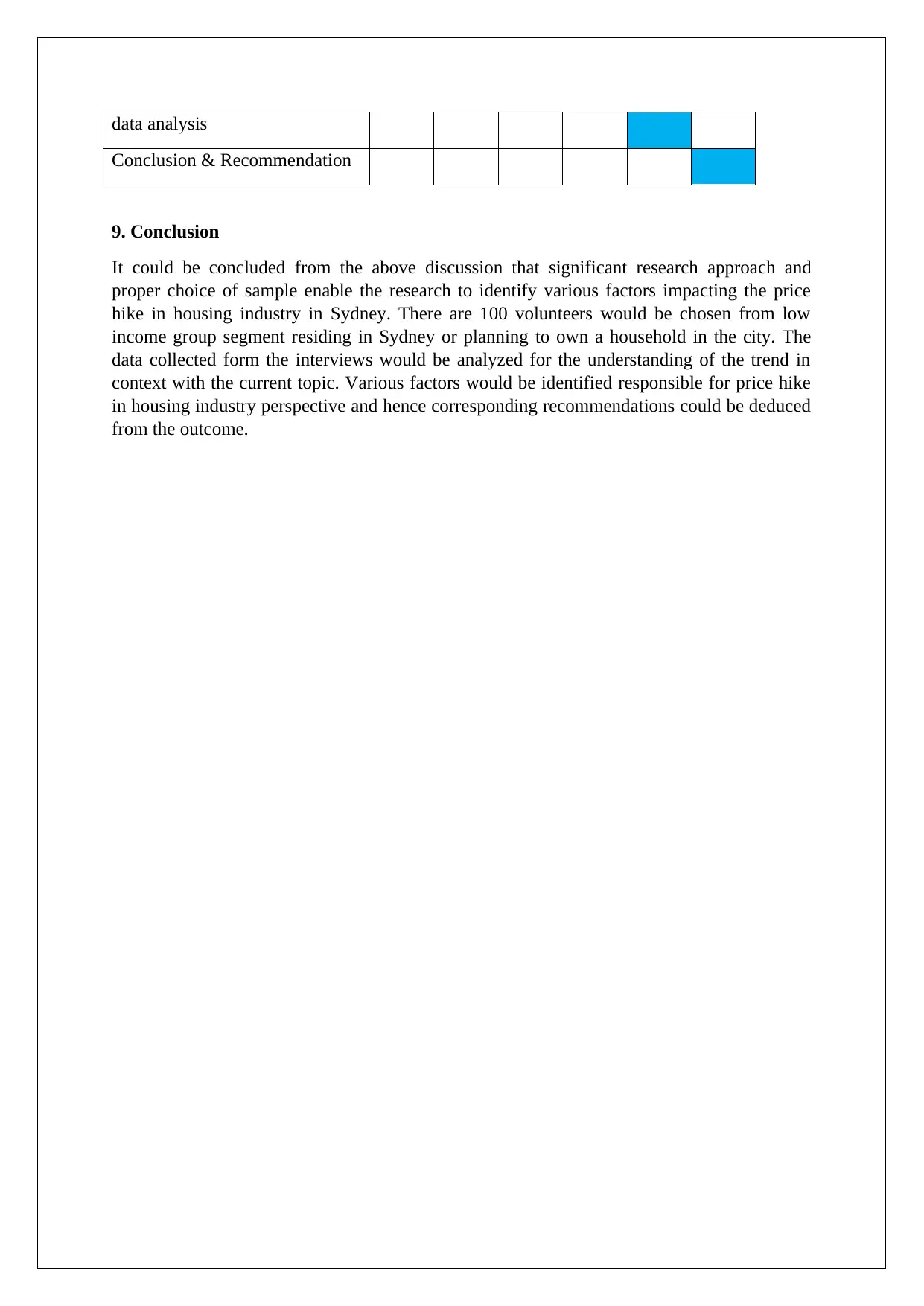
data analysis
Conclusion & Recommendation
9. Conclusion
It could be concluded from the above discussion that significant research approach and
proper choice of sample enable the research to identify various factors impacting the price
hike in housing industry in Sydney. There are 100 volunteers would be chosen from low
income group segment residing in Sydney or planning to own a household in the city. The
data collected form the interviews would be analyzed for the understanding of the trend in
context with the current topic. Various factors would be identified responsible for price hike
in housing industry perspective and hence corresponding recommendations could be deduced
from the outcome.
Conclusion & Recommendation
9. Conclusion
It could be concluded from the above discussion that significant research approach and
proper choice of sample enable the research to identify various factors impacting the price
hike in housing industry in Sydney. There are 100 volunteers would be chosen from low
income group segment residing in Sydney or planning to own a household in the city. The
data collected form the interviews would be analyzed for the understanding of the trend in
context with the current topic. Various factors would be identified responsible for price hike
in housing industry perspective and hence corresponding recommendations could be deduced
from the outcome.
⊘ This is a preview!⊘
Do you want full access?
Subscribe today to unlock all pages.

Trusted by 1+ million students worldwide
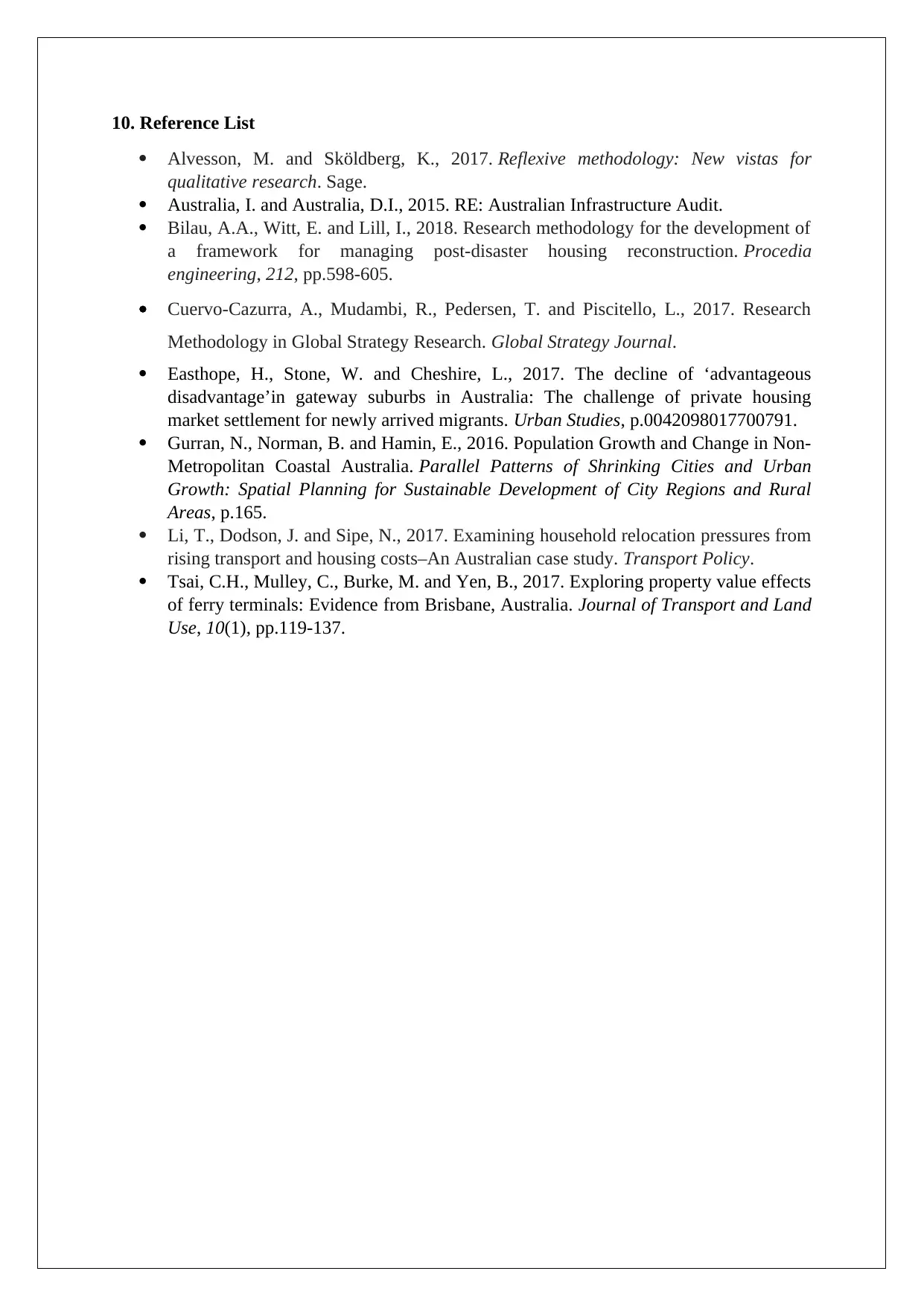
10. Reference List
Alvesson, M. and Sköldberg, K., 2017. Reflexive methodology: New vistas for
qualitative research. Sage.
Australia, I. and Australia, D.I., 2015. RE: Australian Infrastructure Audit.
Bilau, A.A., Witt, E. and Lill, I., 2018. Research methodology for the development of
a framework for managing post-disaster housing reconstruction. Procedia
engineering, 212, pp.598-605.
Cuervo‐Cazurra, A., Mudambi, R., Pedersen, T. and Piscitello, L., 2017. Research
Methodology in Global Strategy Research. Global Strategy Journal.
Easthope, H., Stone, W. and Cheshire, L., 2017. The decline of ‘advantageous
disadvantage’in gateway suburbs in Australia: The challenge of private housing
market settlement for newly arrived migrants. Urban Studies, p.0042098017700791.
Gurran, N., Norman, B. and Hamin, E., 2016. Population Growth and Change in Non-
Metropolitan Coastal Australia. Parallel Patterns of Shrinking Cities and Urban
Growth: Spatial Planning for Sustainable Development of City Regions and Rural
Areas, p.165.
Li, T., Dodson, J. and Sipe, N., 2017. Examining household relocation pressures from
rising transport and housing costs–An Australian case study. Transport Policy.
Tsai, C.H., Mulley, C., Burke, M. and Yen, B., 2017. Exploring property value effects
of ferry terminals: Evidence from Brisbane, Australia. Journal of Transport and Land
Use, 10(1), pp.119-137.
Alvesson, M. and Sköldberg, K., 2017. Reflexive methodology: New vistas for
qualitative research. Sage.
Australia, I. and Australia, D.I., 2015. RE: Australian Infrastructure Audit.
Bilau, A.A., Witt, E. and Lill, I., 2018. Research methodology for the development of
a framework for managing post-disaster housing reconstruction. Procedia
engineering, 212, pp.598-605.
Cuervo‐Cazurra, A., Mudambi, R., Pedersen, T. and Piscitello, L., 2017. Research
Methodology in Global Strategy Research. Global Strategy Journal.
Easthope, H., Stone, W. and Cheshire, L., 2017. The decline of ‘advantageous
disadvantage’in gateway suburbs in Australia: The challenge of private housing
market settlement for newly arrived migrants. Urban Studies, p.0042098017700791.
Gurran, N., Norman, B. and Hamin, E., 2016. Population Growth and Change in Non-
Metropolitan Coastal Australia. Parallel Patterns of Shrinking Cities and Urban
Growth: Spatial Planning for Sustainable Development of City Regions and Rural
Areas, p.165.
Li, T., Dodson, J. and Sipe, N., 2017. Examining household relocation pressures from
rising transport and housing costs–An Australian case study. Transport Policy.
Tsai, C.H., Mulley, C., Burke, M. and Yen, B., 2017. Exploring property value effects
of ferry terminals: Evidence from Brisbane, Australia. Journal of Transport and Land
Use, 10(1), pp.119-137.
1 out of 10
Related Documents
Your All-in-One AI-Powered Toolkit for Academic Success.
+13062052269
info@desklib.com
Available 24*7 on WhatsApp / Email
![[object Object]](/_next/static/media/star-bottom.7253800d.svg)
Unlock your academic potential
Copyright © 2020–2025 A2Z Services. All Rights Reserved. Developed and managed by ZUCOL.





